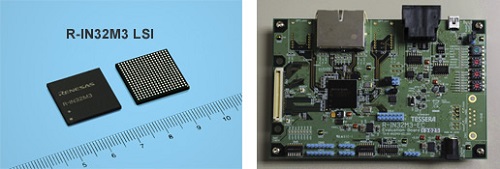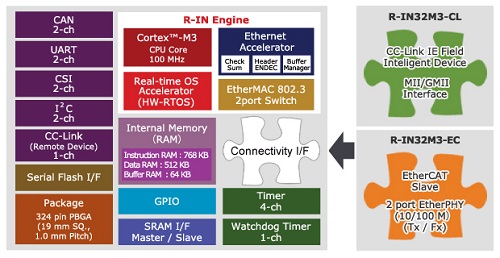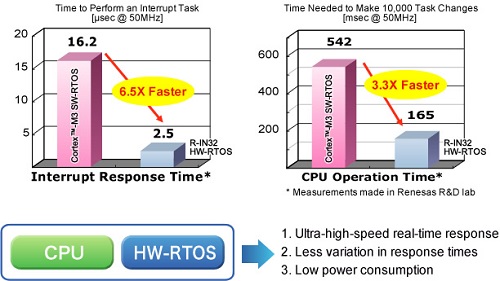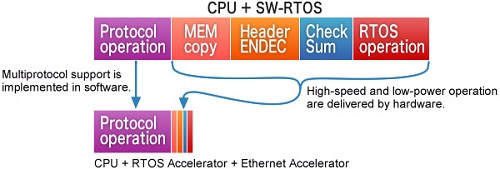
The growth and expansion of factory automation (FA) applications is well established. Industrial robots are replacing human workers, and FA in general is delivering improved efficiency and stability. A recent and very significant development in this area is industrial networks that better support such applications by linking all elements of production systems to the Internet. Specifically, momentum is increasing for an “industrial Ethernet” that interconnects FA machinery via Ethernet-compliant protocols.
Facilitating this system-design advancement, Renesas is shipping samples of a new communication-LSI series tailored specifically for the industrial Ethernet. To learn more about this development, EDGE talked with Akira Denda, General Manager of the Industry & Network Solutions Business Division, 1st Solution Business Unit; and Katsunobu Suzuki, Section Manager of the Industry & Energy SoC Department in that organization.
The interview that follows covers the challenges faced by designers of the computer controlled, networked industrial equipment used to produce many types of products. It also highlights why R-IN32M3 LSI devices are destined to accelerate the proliferation of industrial-Ethernet system designs in a multitude of markets.
Improving industrial networks by expanding Ethernet connectivity into every system layer

EDGE: Gentlemen, please describe the latest advancements in industrial networks today. Are we seeing significant changes in the electronics systems found in factories around the world?
Mr. Denda: As you know, factory automation is based on networks that interconnect a wide variety of machines and equipment. A typical FA network setup is organized as a pyramid, with the system-management computers at the top, as illustrated by the diagrams in Figure 1.
Underneath the top supervisory level is a controller network consisting of programmable logic controllers (PLCs), robots and motor controllers. At the bottom level of the pyramid, on the factory floor, there are the motors, sensors and actuators that perform and monitor the work that the automation system is doing.

Figure 1: The important shift in industrial network design. Many system design, installation and maintenance problems can be eliminated by replacing the diversity of communication protocols typically used today in a conventional industrial network (left), with the Ethernet-compliant ones used in an industrial-Ethernet network (right).
A significant problem with such setups, however, is that today different communication methods typically are used at each layer of the system pyramid. This is illustrated by the diagram on the left in Figure 1
Equipment in the top layer generally uses the standardized, well-proven Ethernet protocol that enables the Internet connectivity necessary for managing multiple facilities and automated machinery installations, while also allowing remote data gathering, productivity monitoring, failure prediction and analysis, etc. By contrast, the implementations and communications standards for the lower layers vary, depending on the firms that built the equipment. Proprietary protocols are typical.
This situation has existed for decades and often results in complex mixes of nonstandard networks. Among other things, it causes installation, maintenance and upgrade problems. It creates flexibility limitations, as well. End users in all types of industrial applications are seeking solutions to these issues.
There is a growing movement to standardize and simplify industrial networks by using Ethernet connectivity for all layers of the system pyramid (see diagram on the right in Figure 1). Using a single, well-established communication protocol to link all of an industrial system’s elements reduces costs and makes it much easier to access information across multiple factories via the Internet, among many other benefits.
Renesas views this factory-automation connectivity trend as a paradigm shift that will drive positive changes and bring important advantages to industrial networking applications in global markets. To accelerate data-communication upgrades, we are producing samples of a new generation of robust, high-performance LSI network-support devices.
Recognizing that production sites have unique performance requirements and need multiprotocol support
EDGE: Ethernet technology is used in offices and households all over the world. Is “industrial Ethernet” any different from the Ethernet connectivity we’re familiar with?
Mr. Suzuki: There are, in fact, a few differences. For example, a number of different Ethernet-compliant protocols are already being applied in industrial applications. Examples include PROFINET, Modbus-IDA, EtherNet/IP, CC-Link IE, Ethernet Powerlink and EtherCAT. This diversity can complicate system implementations if engineers have to specify different communication chips to support each of these protocols.

Another system-design issue is that industrial networks must be fast, highly accurate, and—especially—capable of performing real-time processing within specified time limits. A single programmable logic controller, for instance, might direct an assembly of production equipment containing hundreds of motors and sensors. If the response time of linked equipment is distance dependent, the entire system must slow up to wait for the responses from the farthest machine. This slowdown degrades manufacturing productivity, so its cause should be eliminated or minimized to the greatest extent possible.
Mr. Denda: Because Renesas is a world leader in microcontrollers, our MCUs are used in many thousands of industrial applications around the globe. When our application experts and management learned that customers wanted communication ICs capable of better handling the challenges of applying Ethernet technology in industrial environments, our management initiated R&D programs to create optimized semiconductor solutions.
Our new R-IN32M3 series devices, pictured in Figure 2, are the first Renesas industrial-Ethernet application-specific standard products (ASSPs). Designed specifically to accelerate emerging networking trends in factory-automation applications, these LSI devices deliver fast, real-time, deterministic, low-latency, low-jitter response.

Figure 2: New Renesas communication LSI devices for industrial-Ethernet applications. R-IN32M3 chips provide the fast processing and deterministic, low-latency, low-jitter performance needed for real-time control systems.
Integrating functions that offload communication tasks from the network processor
Mr. Suzuki: The advanced technology built into our new R-IN32M3 series LSIs makes these devices one-chip solutions to the connectivity problems prevalent in industrial environments. As the block diagram in Figure 3 shows, the chips integrate an Ethernet accelerator, 1.3MB of RAM, functions that support multiple Ethernet-compliant protocols, and much more, including a dedicated DMA controller and buffer for the network processor.
These devices’ internal circuits are carefully tailored to deliver the rapid processing essential in real-time control systems. Primary target applications are those in the bottom two levels of the right-hand pyramid in Figure 1.

Figure 3: High-functionality single-chip solutions. Renesas R-IN32M3 series ASSPs include an Ethernet accelerator, 1.3MB of RAM, and circuits supporting Ethernet-compliant protocols, among many other on-chip functions. A key feature is the Real-Time OS Accelerator, which enables rapid task changing and fast interrupt response.
At the present time there are two devices in the R-IN32M3 product line. The main differences between them are the on-chip connectivity interfaces highlighted on the right in the block diagram.
Specifically, the R-IN32M3-CL device has a Gigabit Ethernet MAC and a built-in MII/GMII interface and also features CC-Link IE Field (intelligent device station) support. By contrast, the R-IN32M3-EC chip integrates a 2-port, 10/100Mbps Tx/Fx EtherPHY module and provides EtherCAT slave support.
Both the ‘CL’ and ‘EC’ types of R-IN32M3 LSI devices also support EtherNet/IP and PROFINET (RT), as well as the CC-Link, CANopen and DeviceNet open-network protocols. Support for the Modbus TCP, POWERLINK, and FL-net industrial-Internet protocols is under development.
Achieving overall speeds up to 10 times faster and greatly reducing inconsistencies in response times
EDGE: Data communications LSIs for industrial-Ethernet applications have tougher performance requirements than those used in regular Ethernet implementations. Please describe the functions and capabilities of R-IN32M3 series devices in more detail.

Mr. Suzuki: A major feature of our new ASSPs is a built-in RTOS accelerator—the HW-RTOS, which is a hardware implementation of real-time operating system software. This function is key to the LSI chip’s performance. It minimizes response time by eliminating clock cycles that would otherwise be needed if the chip’s CPU had to process the control algorithm software.
Additionally, the RTOS accelerator compensates for the large response-time variations typically exhibited by different devices in an industrial network. This capability makes system performance more predictable and thereby allows operational fine-tuning that maximizes production rates.
Our R-IN32M3 LSI products use an ARM Cortex-M3 CPU. The RTOS accelerator, though, is a proprietary Renesas design that applies proven, leading-edge ARTESSO technology licensed from KernelOn Silicon, Inc.
As I mentioned previously, the architecture of the on-chip functions is optimized for speed, and the performance of these Renesas industrial-Ethernet communication chips is very successful in that regard. The combination of their CPU and HW-RTOS produces ultra-fast real-time responsiveness. Additionally, the hardware RTOS greatly reduces variations in the timing of operations, making possible tighter, more efficient task scheduling.

Figure 4: Performance of R-IN32M3 industrial-Ethernet communication devices. Compared to an RTOS executed in software, these new LSI devices deliver much faster speeds for better real-time performance because they incorporate a hardware RTOS function.
Conducting performance tests to quantify the LSI devices’ design advantages
Figure 4 shows comparison data from interrupt response time and task-change tests conducted in a Renesas R&D laboratory.
The results of the interrupt response show the time duration of the number of clock cycles between the occurrence of an interrupt at the CPU and the start of the corresponding operation. With a software RTOS, it takes between 850 and 2,000 clock cycles before the new operation starts. But an R-IN32M3 LSI drops this down to between 124 and 150 cycles, enabling a factory-automation system to react more quickly to normal or unexpected operational events.
As the left-hand graph in Figure 4 reveals, the HW-RTOS function in the new Ethernet communication chips processes interrupts an average of 85 percent quicker than a Cortex™-M3 processor running a software RTOS. Put another way, the data show that an R-IN32M3 chip handles interrupts from 5.6 to 16 times faster. Additionally, other test results reveal that variations in the interrupt response times are reduced to 1/40th of their previous level.
The graph on the right in Figure 4 compares the time it takes to switch between tasks when two tasks are running. As you can see, an R-IN32M3 series device does so in less than one-third of the time required by the CPU running a software RTOS. In an actual system, many tens of tasks typically run simultaneously, so our latest LSI devices would enable even bigger speed increases.
The test results summarized in Figure 4’s graphs were obtained when a prototype communication chip was running at 50MHz. However, our newly released, advanced LSI devices operate at up to 100MHz, so they can deliver much faster processing and even lower response-time variations. Indeed, the 100MHz chips achieve unprecedented levels of performance.
Cutting power consumption while providing high levels of computing capability
Mr. Denda: Of course, by executing each process much faster, less power is consumed per process. This is important because customers in the factory-automation industry often ask us to meet three different requirements at the same time: higher speed, the ability to communicate larger volumes of data, and lower power consumption.

Here is a good example of an application in which power consumption is very important. A machine on a semiconductor fabrication line has to position silicon wafers with extreme precision. A fan can’t be used to cool its electronics because that would create an intolerable amount of vibration. Therefore, system engineers must keep the power consumed by the electronics low enough that the operating temperatures of components on the machine’s control board remain within acceptable limits in the absence of forced-air cooling.
It’s typical for such a machine to handle tasks requiring so much computing throughput that its main processor has to run at 300MHz to 400MHz rates that generate lots of heat. If that is the case, the engineering team must find a way to obtain the requisite computational capability while also slowing down that CPU.
An excellent design solution to this problem is to offload the main processor of the semiconductor fabrication machine by adding an R-IN32M3 LSI to its control board. With both that processor and the Renesas chip operating at just 50MHz, the necessary computing and communication functions are maintained, yet power consumption decreases to acceptably lower levels.
Boosting speed without limiting system design flexibility
Mr. Suzuki: It has been our experience, though, that system engineers often cite a common objection to using hardware acceleration to resolve speed and power issues. They are likely to point out that there is a significant design tradeoff when applying function modules. Although the hardware increases speed, it can also limit design flexibility. In communication applications, this limitation can make providing support for multiple protocols more difficult, for example.
Renesas R-IN32M3 series devices address this objection directly and offer a solution for such concerns. The chips ensure system design flexibility by implementing the protocol processing component, as well as a part of the RTOS, in software. This partitioning method is diagrammed in Figure 5.

Figure 5: Architecture for achieving both high speed and design flexibility. The optimum system design solution divides the required processing operations in a way that lets the hardware deliver speed at low power, while the software implements multiprotocol support.
Moving toward gigabit Ethernet capability and motion control
EDGE: Now that samples of R-IN32M3 LSI devices are being shipped, what are Renesas’ future plans for this line of industrial-Ethernet communication chips?
Mr. Denda: Renesas is a member of most of the local and international organizations that set policies for industrial-Ethernet standards, and our participation lets us respond quickly to emerging needs. In particular, we are currently looking at expanding the range of factory-automation applications we can serve by developing new devices in the R-IN32M3 product line that incorporate Gigabit PHY capability and are suitable for network-driven motion (motor) control applications. Looking beyond the factory-automation markets, we are aiming to extend industrial-Ethernet chip support to the design of various types of equipment that make network transfers of large data volumes.
The circuit design and processing technologies that are the foundation of our new R-IN32M3 series can be adapted to handle a wide range of communication and control requirements. This gives us many opportunities to meet customer needs and thus grow our market successes and sales volume around the world.
In the future, products containing R-IN32M3 LSI chips will be deployed in factories throughout the world. Their underlying technological strengths will also make them ideal system design choices for many of the applications that will emerge as network connectivity becomes ever more important and pervasive in all aspects of our daily lives.

EDGE: We thank you both for giving us your insights today.
Advertisement
Learn more about Renesas Electronics America





